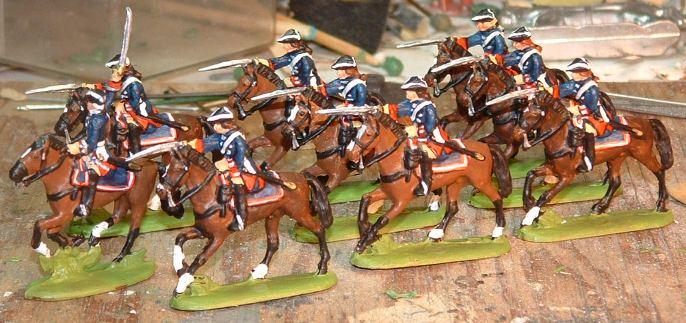 |
| The Faraway Ministry of Defence has analyzed the recent string of defeats and having spotted the likely reason behind the Oberhilse successes, has taken quick steps to reequip Her Majesty's soldiers. Can you guess what their conclusion was? |
I did mean to offer some comprehensive comments on last week's game but I'm afraid that time has dulled my memory of details and also altered my interpretation of events and left me less sure about what did and didn't work and why.
The scenario was simple enough I pulled a bunch of Blue army units off the shelf, avoiding any of the Mexican War and 1812 style uniforms. Then I pulled a few Red figures down and decided to let the commander pull down more as reinforcements till I figured he had enough. Blue's mission was to capture the bridge and hold a secure line of communications.
 |
| An overview of the setup. |
Blue's force comprised a General, 2 infantry regiments each consisting of a commander and 4 companies, a detachment of Guards with commander and 2 5 figure companies, 2 batteries of the latest imoroved rifled, breechloading artillery and a squadron of mounted rifles (irregular cavalry with rifles, superior fire power, inferior melee.)
One of the problems with dice based activation systems is that every now and then the rolls come out lopsided for several turns in a row sometimes at a critical point. That happened here, just as Red was trying to bring on reinforcements he ran into a string of 1s and 2s. By the time the order dice returned to average, the advance guard of cavalry had been shot to pieces with little damage or delay to the attackers. A charge by the 2 troops of lancers saw them throw a fistful of 2s and 3s, not even a 1 to force the enemy back. Then the last surviving lancer pulled back to a safe place for the rest of the game.
When pulling troops off the shelf before deciding to play a game I had grabbed some old Crescent WW1 15lbers with Oberhilse crews (the 40mm Prussian gunners are a perfect fit, the seated gunner can actually fit on the aimer's seat) so I just included them. When the FTC horse artillery finally showed with their smoothbore muzzle loaders they were shot to pieces in no time. Oops. Sorry guys.
 The Red Force has finally brought almost as many troops onto the table as Blue but because of early losses Blue still out numbers them by 2:1 and holds the road up to the middle of town. |
A more serious one which also cropped up in the acw test was that shooting was more effective than I liked. In part though that comes down to what shooting represents and what melee/assault/close combat represents. The theory is that with grids being somewhere around 150 yds per area, all decisive small arms fire happens in melee and shooting is basically harrassing or skirmisher fire. However, somehow that doesn't feel right and obliterates the difference between firefights and bayonet charges.
By ignoring scale that difference could be added easily but possibly with other issues. Another option might be to add modifiers or start fiddling with a difference between adjacent and in contact, easy enough with small units on a large grid but tricky if units fill a grid area.
While I was working on my shortened, grid friendly train I realized that this meant that I was subconsciously intending to play more skirmish like games which also raises the question of scale. If designing purely for effect scale issues may be over ruled in favour of what looks/feels right. It just requires overcoming 40 years of conditioning, something I've been struggling with for at least 15 years.
Oddly enough both of these issues, the shooting/melee issue and the using one rule set for both small battles and skirmishes cropped up with Hearts of Tin in 2009 during the Game a Week project and were successfully resolved at the time. Also oddly enough it occurred to me during the game that despite minor differences, the effect of units of individual figures on a grid was very similar to the effect of single base units without the grid such as in Morschauser or sometimes in smaller HofT games a few years ago.
All just food for thought at the moment.





































